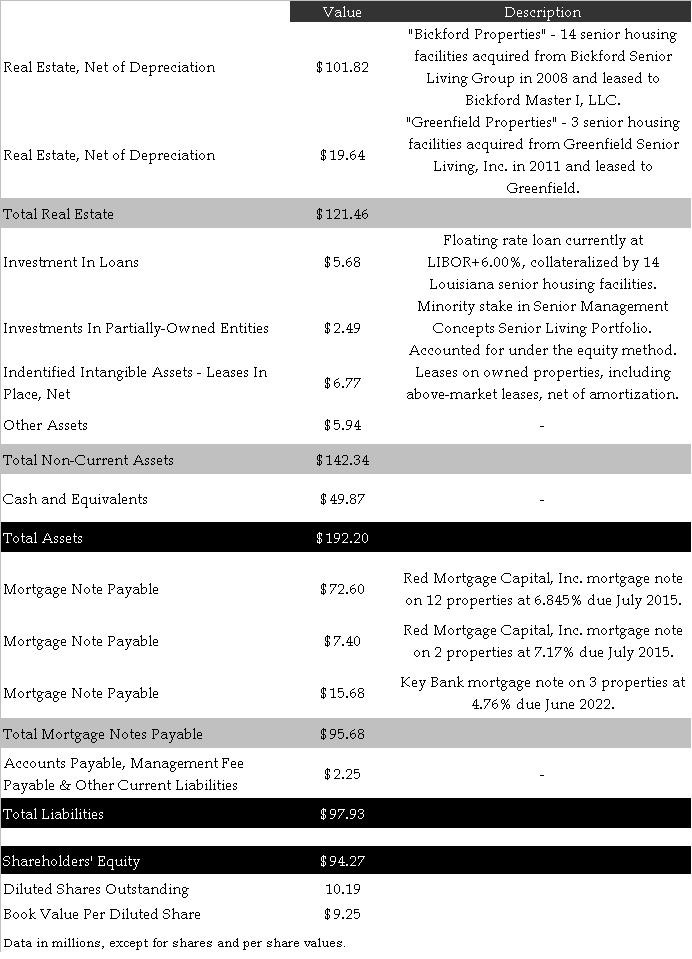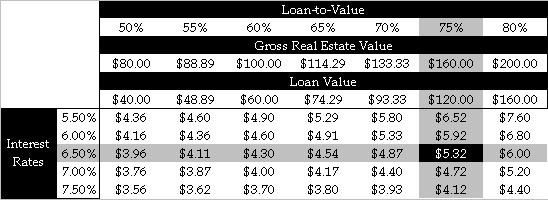Care Investment Trust
Care Investment Trust owns senior housing facilities and senior housing-related debt assets. The company operates as a REIT. The company trades (quote) at a 7.8% yield and has significant excess capital.
Originally formed to invest in healthcare-related mortgages issued by CIT Group (before CIT's 2009 bankruptcy) the company ran into trouble in the turbulent credit markets of 2008. After weighing various alternatives, including liquidation, the company ultimately sold a majority stake to Tiptree Financial Partners. Tiptree is managed by Tricadia Capital, a New York-based hedge fund. Care Investment Trust used the cash proceeds of the transaction to make a tender offer for all shares outstanding, ultimately resulting in a 92.2% ownership stake for Tiptree. Insiders own 93.2% as of the most recent proxy statement. Because of its extremely low public float, the company was involuntarily relieved of its NYSE listing.
Since its restructuring, Care Investment Trust has undertaken multiple transactions, both purchasing and divesting interests in senior housing properties. As of March 31, 2012, the company's balance sheet looks like this:

Note: the balance sheet has been adjusted for the Key Bank mortgage note refinancing that occurred on April 24, 2012. Total liabilities and equity are estimates and may differ slightly from actual figures.
A brief consideration of the balance sheet reveals a few notable observations.
1. The company is under-leveraged. Loan-to-Book value on the owned properties is 78.8%, but only 37.7% when the company's cash is taken into account. Investing this excess cash in additional senior housing assets could substantially increase funds from operations.
2. The company's debt maturity profile is a concern. The weighted average maturity of the company's outstanding mortgage debt is just 4.30 years. Extending the average maturity of the company's mortgage notes by several years would greatly reduce the company's financing risk.
3. At a recent trading price of around $6.95, the company trades at only 75% of book value, nearly all of which is tangible. Many companies might try to build shareholder value by repurchasing shares below book value, but Care Investment Trust is limited by the fact that so few shares (fewer than 700,000) are held by non-Tiptree investors. Care Investment Trust will have to rely on the whims of the market to realize a higher valuation.
Care Investment Trust resumed quarterly dividend payments after the third quarter of 2011, paying shareholders 13.5 cents per share. The company's adjusted funds from operation were 7 cents per share last quarter, so current cash flows don't quite support the dividend. Fortunately, the company's excess cash creates significant investment opportunities that could increase distributable cash flow greatly.
Care Investment Trust has nearly $50 million in cash on hand against minimal current liabilities, so I think it's safe to assume the company can devote $40 million or so into new senior housing investments. The company executed its 2008 Bickford purchase and lease at an initial lease yield of 8.21%. The lease is triple-net, meaning the client is solely responsible for expenses like repairs, taxes, utilities and others. Assuming the company can execute similar 8.20% yield leases, the chart below illustrates net cash flow to the company under various leverage and interest rate scenarios.

If the company maintains loan-to-value ratios and mortgage rates similar to its previous transactions, investing $40 million could yield $5.32 million in additional funds from operations.
However, how do we account for depreciation on these owned properties? There is often a wide gulf between the amount of depreciation expense shown on REIT income statements and the actual amount of capital expenditure by the company, year after year. The upshot is that much of the depreciation expense shown on the income statement is accounting depreciation only, not actual economic depreciation representing the deterioration of assets. Long-lived assets such as real estate often maintain significant value long after being depreciated to $0 on corporate balance sheets. Additionally, real estate prices tend to rise in the long run (emphasis on long run) which helps offset real economic depreciation. For the sake of conservatism, I will assume that all the depreciation indicated in Care Investment Trust's financial statements is a real loss of economic value. In 2011, depreciation on the company's Bickford assets was 2.90%. I think a conservative and defensible assumption on the long-term appreciation of real estate properties is 2.0% annually. Using a 2.90% depreciation figure and a long-term real estate appreciation figure of 2.00% indicates an annual real depreciation cost of 0.90% of property value. The chart below incorporates this net depreciation to estimate economic cash flow to the company after investing $40 million.

Assuming leverage and financing costs comparable to previous transactions, the company may be capable generating another $3.88 million in economic cash flow per year, or 38 cents per diluted share.
Adding 38 cents per share in yearly adjusted funds from operations to the existing 28 cents per share would yield 66 cents per share, a yield of 9.5% at the current trading price. In order to maintain the present yield of 7.8%, the company's price would have to appreciate by 22% to $8.46 per share.
Larger health care-focused REITS currently trade at yields of around 5.5%. Care Investment Trust does not deserve to trade at those levels due to its illiquidity and small size, but even trading down to a 6.5% yield after investing $40 million would result in a trading price of $10.15, a gain of 46.4%.
Of course, Care Investment Trust's management might make a terrible acquisition and waste its firepower. The funding environment might lock up and make new investments all but impossible. Economic uncertainty and budget pressures might make senior housing less tenable for the elderly. Still, Tiptree owns over 90% of the company and will be extremely motivated to grow its value. The company's significant excess cash provides stability for now, and the ability to make a transformational investment at an opportune time. Until then, investors will be rewarded with an attractive yield on current prices. Care Investment Trust is a conservative real estate investment with significant potential for increased dividends and capital gains.
No position.


